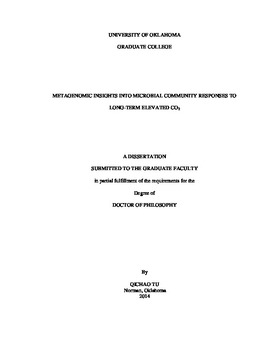| dc.description.abstract | Understanding how belowground microbial communities respond to increasing atmospheric CO2 is of crucial importance for global change biology, microbial ecology and predictive biology. However, our understanding of CO2 effects on microbial communities is still limited, especially due to the immense diversity and as yet-uncultivable nature of most soil microorganisms. By implementing next generation sequencing (NGS) technologies, we comprehensively surveyed the responses of microbial communities to elevated CO2 (eCO2) in the BioCON experimental site, a grassland ecosystem, which had been exposed to eCO2 for 12 years.
In the beginning of this study, it was noticed that computational approaches to identify microbial strains/species from shotgum metagenomes are very limited, thus we have developed a computational algorithm, termed GSMer that identifies genome-specific markers (GSMs) from currently sequenced microbial genomes for strain/species identification in metagenomes. Although GSMer was not very successfully applied in our soil metagenomes due to the extremely low coverage and high diversity of soil microbial communities as well as short sequencing reads from early Illumina GAII performs, it was successfully used to analyze microbial communities with a good coverage of reference genomes, such as human microbiomes. Sensitivity evaluation against synthetic metagenomes with different levels of coverage suggested that 50 GSMs per strain were sufficient to identify most microbial strains with ≥ 0.25x coverage, and 10% of selected GSMs in a database should be detected for confident positive callings. Application of GSMs respectively identified 45 and 74 microbial strains/species significantly associated with type-2-diabetes (T2D) patients and obese/lean individuals from corresponding gastrointestinal tract metagenomes. Our results agreed well with previous studies, but provided strain-level information.
In the following, we analyzed the biodiversity, composition, structure and functional potential of soil microbial communities in response to eCO2 at multiple (e.g., phylogenetic, taxonomic, genetic, functional) dimensions using next generation sequencing approaches. For each dimension of microbial biodiversity, all components of diversity, including alpha-, beta- and gamma-diversity were analyzed. Our results suggested that long-term eCO2 decreased the overall microbial biodiversity. Beta-diversity analysis suggested eCO2 decreased functional beta-diversity, but increased taxonomic and phylogenetic diversity, suggesting long-term eCO2 selected for microbial function rather than taxonomy. Further meta-analysis suggested that such decreased biodiversity was significantly negatively correlated with increased soil ammonification rate. Moreover, the abundance of gene families involved in ammonium producing pathways increased significantly as well, indicating a functional convergence process as a result of higher demand for biologically available nitrogen (N) by stimulated plant growth as a result of eCO2. Our findings present evidence that plant-microbe interactions for NH4+ as result of progressive nitrogen limitation were an important driving factor, responsible for decreased microbial biodiversity under eCO2.
We also analyzed the response of fungal communities to long-term eCO2 by sequencing of 28S rRNA gene amplicons. Long-term eCO2 did not significantly alter the overall fungal community structure and species richness, but significantly increased community evenness and diversity. Relative abundances of 119 OTUs (~ 27% of the total captured sequences) were changed significantly. More interestingly, significantly changed OTUs under eCO2 were associated with increased overall relative abundance of Ascomycota, but decreased relative abundance of Basidiomycota. Co-occurrence ecological network analysis indicated that eCO2 increased fungal community interactions, as evidenced by higher intermodular and intramodular connectivity and shorter geodesic distance. In contrast, decreased connections for dominant fungal species were observed in the eCO2 network. Community reassembly of unrelated fungal species into highly connected dense modules was observed. Such changes in the network structure were significantly associated with altered soil and plant properties under eCO2, especially with increased plant biomass and NH4+ availability. This study provides novel insights into our understanding of how eCO2 shapes soil fungal communities in grassland ecosystems.
Since it was noticed that changes of both belowground microbial biodiversity and fungal communities were significantly correlated with soil ammonification rate, and our previous studies showed that the abundance of nifH significantly increased at eCO2, we hypothesized that N2-fixing microorganisms would play important roles in response to eCO2. Therefore, we analyzed N2-fixing communities by sequencing of nifH gene amplicons as well as extraction of nifH fragments from shotgun metagenomes. Surprisingly, long-term eCO2 significantly increased the abundance of nifH genes, but did not change the overall nifH diversity and diazotrophic community structure. Taxonomic and phylogenetic analysis of amplified nifH sequences suggested a high diversity of nifH genes in the soil ecosystem, with the majority belonging to cluster I and II nifH genes. We then constructed a microbial ecological network using 16S rRNA gene and nifH gene profiles. Co-occurrence ecological network analysis suggested a clear preference of co-occurrence patterns between diazotrophs and other microbial species with different patterns observed for different subgroups of diazotrophs, such as Azospirillum/Actinobacteria, Mesorhizobium/Conexibacter, and Bradyrhizobium/Acidobacteria. This indicated a potential attraction of these non-N2-fixers by diazotrophs in the soil ecosystem. Interestingly, more complex co-occurrence patterns were found for free-living diazotrophs than commonly known symbiotic diazotrophs, consistent with the physical isolation nature of symbiotic diazotrophs from the environment by root nodules. The study provides novel insights of our understanding microbial ecology of soil diazotrophs in natural ecosystems.
All studies included in this work provided novel insights into the long-term eCO2 effects on belowground microbial communities, which are of merit for next generation sequencing analysis for microbial ecologists, global change biologists and bioinformaticians. | en_US |
